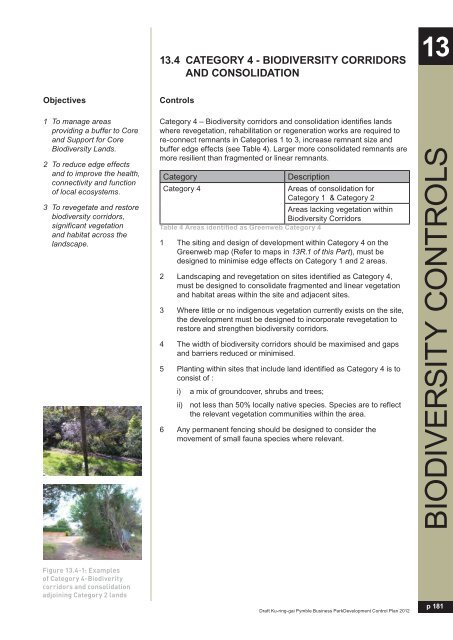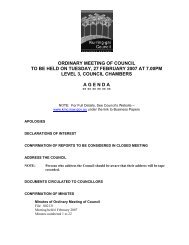Pymble Business Park - Ku-ring-gai Council
Pymble Business Park - Ku-ring-gai Council
Pymble Business Park - Ku-ring-gai Council
You also want an ePaper? Increase the reach of your titles
YUMPU automatically turns print PDFs into web optimized ePapers that Google loves.
13.4 CATEGORY 4 - BIODIVERSITY CORRIDORS<br />
AND CONSOLIDATION<br />
13<br />
Objectives<br />
Controls<br />
1 To manage areas<br />
providing a buffer to Core<br />
and Support for Core<br />
Biodiversity Lands.<br />
2 To reduce edge effects<br />
and to improve the health,<br />
connectivity and function<br />
of local ecosystems.<br />
3 To revegetate and restore<br />
biodiversity corridors,<br />
significant vegetation<br />
and habitat across the<br />
landscape.<br />
Category 4 – Biodiversity corridors and consolidation identifi es lands<br />
where revegetation, rehabilitation or regeneration works are required to<br />
re-connect remnants in Categories 1 to 3, increase remnant size and<br />
buffer edge effects (see Table 4). Larger more consolidated remnants are<br />
more resilient than fragmented or linear remnants.<br />
Category<br />
Category 4<br />
Description<br />
Areas of consolidation for<br />
Category 1 & Category 2<br />
Areas lacking vegetation within<br />
Biodiversity Corridors<br />
Table 4 Areas identified as Greenweb Category 4<br />
1 The siting and design of development within Category 4 on the<br />
Greenweb map (Refer to maps in 13R.1 of this Part), must be<br />
designed to minimise edge effects on Category 1 and 2 areas.<br />
2 Landscaping and revegetation on sites identified as Category 4,<br />
must be designed to consolidate fragmented and linear vegetation<br />
and habitat areas within the site and adjacent sites.<br />
3 Where little or no indigenous vegetation currently exists on the site,<br />
the development must be designed to incorporate revegetation to<br />
restore and strengthen biodiversity corridors.<br />
4 The width of biodiversity corridors should be maximised and gaps<br />
and barriers reduced or minimised.<br />
5 Planting within sites that include land identified as Category 4 is to<br />
consist of :<br />
i) a mix of groundcover, shrubs and trees;<br />
ii) not less than 50% locally native species. Species are to reflect<br />
the relevant vegetation communities within the area.<br />
6 Any permanent fencing should be designed to consider the<br />
movement of small fauna species where relevant.<br />
BIODIVERSITY CONTROLS<br />
Figure 13.4-1: Examples<br />
of Category 4-Biodiverity<br />
corridors and consolidation<br />
adjoining Category 2 lands<br />
Draft <strong>Ku</strong>-<strong>ring</strong>-<strong>gai</strong> <strong>Pymble</strong> <strong>Business</strong> <strong>Park</strong>Development Control Plan 2012<br />
p 181

















